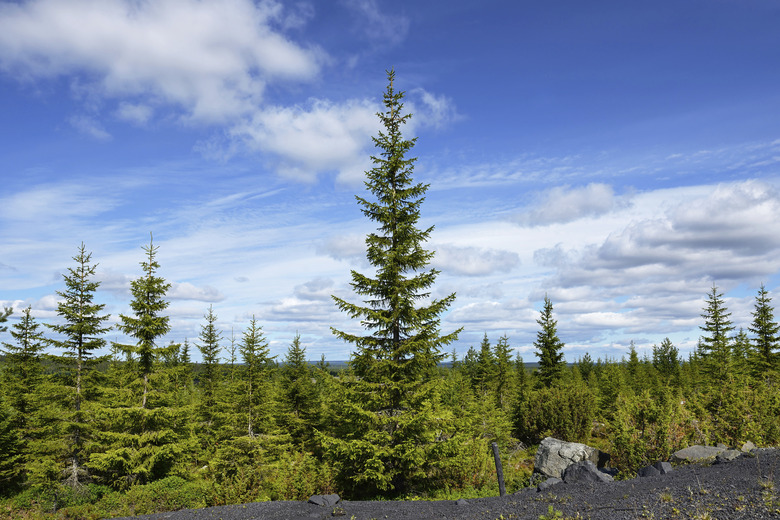Taiga Plant Adaptations
The taiga, or boreal forest, constitutes the world's largest terrestrial biome. The taiga location separates the temperate and arctic latitudes; it's essentially an enormous and sparsely populated belt of woods. The prevailing subarctic climate can be ferocious, with a striking sweep of annual temperatures.
Read more about the plants and animals in the Taiga Biome.
Verkhoyansk, Siberia has endured a winter low of -70 degrees Celsius (-94 degrees Fahrenheit) and a summer high of 30 degrees C (86 degrees F) in the same year. The hardy taiga biome plants that compose the taiga ecosystem demonstrate numerous adaptations for its rigors.
Evergreen vs. Deciduous
Evergreen vs. Deciduous
Evergreen conifers dominate large swaths of the circumboreal region. In this realm of weak sunlight, a short growing season and nutrient-poor soil, the deciduous strategy of regrowing leaves in spring is often too costly in terms of time and energy. Evergreens are ready to photosynthesize as soon as conditions allow.
Read more about how pine trees photosynthesize.
That said, the northernmost fringe of the taiga experiences winters so fierce that hardy deciduous species such as birches and larches — among the few conifers that lose all their needles annually — may outcompete most evergreens, because they can more effectively shut down during the rigors of the cold season. The severely cold "light taiga" of eastern Siberia is so-named because of its predominant larch forests. Even where evergreen conifers dominate, deciduous hardwoods such as aspens, poplars and birches can flourish in forest gaps opened by fires or windstorms.
Taiga Biome Plants and Contending with Snow
Taiga Biome Plants and Contending with Snow
The conical shape of taiga conifers such as spruces and firs — which reflects bud-growth mechanisms, branch aging and the natural droop of the limbs — seems well-designed for the environment. These narrow cones shed snow more effectively than a wide-canopied shape.
The hardwoods that do thrive in the boreal forest have their own taiga plant adaptations to contend with snow load. Birches and aspens, for example, have flexible limbs that can bend beneath snow without breaking.
Dealing with Fire
Dealing with Fire
Given the long winters of the boreal latitudes, it may be surprising to learn that wildfire is a common and influential sculpting force in the taiga. Lightning-sparked blazes intensify into great crown fires given the density of short, thick-branched conifers and the heavy mantle of forest-floor litter. These conflagrations help enrich the acidic taiga soil, naturally nutrient-deficient and well-leached.
Many boreal trees have developed taiga plant adaptations to be fire-tolerant and even fire dependent. Some populations of jack pine and black spruce, for example, require the intense heat of a wildfire to open their cones and spread seeds — a trait called serotiny.
Many other species are adapted for quickly colonizing burnt tracts. Aspens, for instance, can sprout from their roots, and also efficiently broadcast large quantities of their lightweed seeds — just like fireweed, birch, balsam poplar and eastern white pine. Boreal fires may intensify as global warming — which also threatens the taiga's permafrost layer — reduces precipitation in the high latitudes.
Warding Off the Elements
Warding Off the Elements
Though the boreal forest is reasonably well-watered and is often laced with mires because of poor drainage as a result of taiga location, taiga biome plants still must protect themselves against excess drying. In winter, much of the soil water may be frozen and thus unavailable, and cold, dry winds threaten to rob exposed leaves of moisture. The evergreen needles of conifers limit drying with their waxy coating and reduced stomata, the organs that facilitate air and water transfer across the leaf.
Shrubs and herbs of the forest floor in the taiga location are often low-lying so that they may be insulated from desiccation and cold beneath the winter snowpack. As Glenda Daniel and Jerry Sullivan note in "A Sierra Club Naturalist's Guide to the North Woods," the same waterproof quality that recommends the bark of the paper birch to canoe makers protects the tree against moisture loss.
References
- University of California Museum of Paleontology: The World's Biomes — The Forest Biome
- The Encyclopedia of World Climatology; John E. Oliver
- World Wildlife Fund: Boreal Forests/Taiga
- Trees: Their Natural History; Peter A. Thomas
- Alaska Department of Fish and Game: Boreal Forest in Alaska — Ecology
- U.S. Environmental Protection Agency: Climate Impacts in Alaska
- National Aeronautics and Space Administration: Wildfires: A Symptom of Climate Change
- The Boreal Ecosystem; James A. Larsen
Cite This Article
MLA
Shaw, Ethan. "Taiga Plant Adaptations" sciencing.com, https://www.sciencing.com/taiga-plant-adaptation-7895031/. 29 July 2019.
APA
Shaw, Ethan. (2019, July 29). Taiga Plant Adaptations. sciencing.com. Retrieved from https://www.sciencing.com/taiga-plant-adaptation-7895031/
Chicago
Shaw, Ethan. Taiga Plant Adaptations last modified March 24, 2022. https://www.sciencing.com/taiga-plant-adaptation-7895031/
